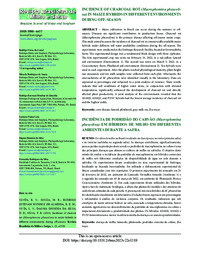Embrapa Milho e Sorgo
Incidence of charcoal rot (Macrophomina phaseolina) in maize hybrids in different environments during off-season.
Incidence of charcoal rot (Macrophomina phaseolina) in maize hybrids in different environments during off-season.
Autoria: COSTA, R. V. da; SOUZA, M. R. de; ALMEIDA, R. E. M. de; COTA, L. V.; SILVA, D. D. da; SILVA, F. R. da
Resumo: Maize cultivation in Brazil can occur during the summer or offseason. Diseases are significant contributors to production losses. Charcoal rot (Macrophomina phaseolina) is the primary disease affecting off-season maize crops. This study aimed to assess the incidence of charcoal rot in commercially available maize hybrids under different soil water availability conditions during the off-season. The experiments were conducted at the Embrapa Research Facility, located at Invernadinha Farm. The experimental design was a randomized block design with three replicates. The first experimental crop was sown on February 21, 2022, in a red-yellow Latosol soil environment (Environment 1). The second was sown on March 3, 2022, in a Concretionary Petric Plinthosol soil environment (Environment 2). Ten hybrids were used in each experiment. After the plants reached physiological maturity, plant height was measured, and ten stalk samples were collected from each plot. Afterwards, the microsclerotia of M. phaseolina were identified visually in the laboratory. Data are expressed as percentages and subjected to a joint analysis of variance. These results indicate that soil conditions of higher water stress, in conjunction with elevated temperatures, significantly enhanced the development of charcoal rot and directly affected plant productivity. A joint analysis of the environments revealed that the AS1820, AS1822, and P3707 hybrids had the lowest average incidence of charcoal rot and the highest yields.
Ano de publicação: 2023
Tipo de publicação: Artigo de periódico
Unidade: Embrapa Milho e Sorgo
Palavras-chave: Corn, Doença de Planta, Gray stalk rot, Latossolo, Milho, Plant diseases and disorders, Plinthosols, Plintossolo, Podridão do Colmo, Zea Mays

